Home Tags Posts tagged with "NASA"
NASA
The Curiosity rover remains perfectly on course to make its Monday (GMT) landing on the Red Planet, NASA says.
The NASA robot’s flight trajectory is so good engineers cancelled the latest course correction they had planned.
To be sure of touching down in the right place on the surface, the vehicle must hit a box at the top of the atmosphere that is just 3 km by 12 km.
“Our inbound trajectory is right down the pipe,” said Arthur Amador, Curiosity’s mission manager.
“The team is confident and thrilled to finally be arriving at Mars, and we’re reminding ourselves to breathe every so often. We’re ready to go.”
Curiosity’s power and communications systems are in excellent shape.
The one major task left for the mission team is to prime the back-up computer that will take command if the main unit fails during the entry, descent and landing (EDL) manoeuvres.
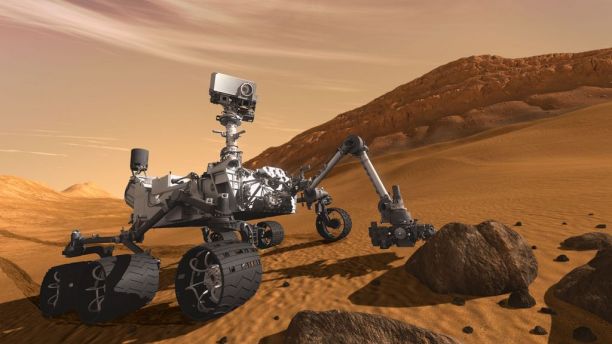
The Curiosity rover remains perfectly on course to make its Monday (GMT) landing on the Red Planet
Curiosity – also known as the Mars Science Laboratory – has spent the past eight months travelling from Earth to Mars, covering more than 560 million km.
The robot was approaching Mars at about 13,000 km/h on Saturday. By the time the spacecraft hits the top of Mars’ atmosphere, about seven minutes before touch-down, gravity will have accelerated it to about 21,000 km/h.
The vehicle is being aimed at Gale Crater, a deep depression just south of the planet’s equator.
It is equipped with the most sophisticated science payload ever sent to another world.
Its mission, when it gets on the ground, is to characterize the geology in Gale and examine its rocks for signs that ancient environments on Mars could have supported microbial life.
Touch-down is expected at 05:31 GMT (06:31 BST) Monday 6 August; 22:31 PDT, Sunday 5 August.
It is a fully automated procedure. NASA will be following the descent here at mission control at the Jet Propulsion Laboratory in Pasadena, California.
The rover will broadcast X-band and UHF signals on its way down to the surface.
These will be picked up by a mix of satellites at Mars and radio antennas on Earth.
The key communication route will be through the Odyssey orbiter. It alone will see the rover all the way to the ground and have the ability to relay UHF telemetry straight to Earth.
And mission team members remain hopeful that this data will also include some images that Curiosity plans to take of itself just minutes after touching the ground.
These would be low-resolution, wide-angle, black and white images of the rear wheels.
They may not be great to look at, but the pictures will give engineers important information about the exact nature of the terrain under the rover.
A lot has been made of the difficulty of getting to Mars, and historically there have been far more failures than successes (24 versus 15), but the Americans’ recent record at the Red Planet is actually very good – six successful landings versus two failures.
Even so, NASA continues to downplay expectations.
“If we’re not successful, we’re going to learn,” said Doug McCuistion, the head of the US space agency’s Mars programme.
“We’ve learned in the past, we’ve recovered from it. We’ll pick ourselves up, we’ll dust ourselves off, we’ll do something again; this will not be the end.
“The human spirit gets driven by these kinds of challenges, and these are challenges that drive us to explore our surroundings and understand what’s out there.”
The mission team warned reporters on Saturday not to jump to conclusions if there was no immediate confirmation of landing through Odyssey.
There were “credible reasons”, engineers said, why the UHF signal to Odyssey could be lost during the descent, such as a failure on the satellite or a failure of the transmitter on the rover.
Continued efforts would be made to contact Curiosity in subsequent hours as satellites passed overhead and when Gale Crater came into view of radio antennas on Earth.
“There are situations that might come up where we will not get communications all the way through [to the surface], and it doesn’t necessarily mean that something bad has happened; it just means we’ll have to wait and hear from the vehicle later,” explained Richard Cook, the deputy project manager.
This was emphasized by Allen Chen, the EDL operations lead. His is the voice from mission control that will be broadcast to the world during the descent. He will call out specific milestones on the way down. He said there would be no rush to judgement if the Odyssey link was interrupted or contained information that was “off nominal”.
“I think we proceed under any situation as though the spacecraft is there, and there for us to recover – to find out what happened,” he said.
“That’s the most sensible thing to do. There are only a few instances I think where you could know pretty quickly that we’d be in trouble.”
The Petermann Glacier in northern Greenland has calved an iceberg twice the size of Manhattan, scientists say.
Images from a NASA satellite show the island breaking off a tongue of ice that extends at the end of the glacier.
In 2010 an ice island measuring 250 square km (100 square miles) broke off the same glacier.
Glaciers do calve icebergs naturally, but the extent of the changes to the Petermann Glacier in recent years has taken many experts by surprise.

The Petermann Glacier in northern Greenland has calved an iceberg twice the size of Manhattan
“It is not a collapse but it is certainly a significant event,” Eric Rignot from NASA said in a statement.
Some other observers have gone further. “It’s dramatic. It’s disturbing,” University of Delaware’s Andreas Muenchow told the Associated Press.
“We have data for 150 years and we see changes that we have not seen before,” Andreas Muenchow added.
However, the calving is not expected have an impact on sea levels as the ice was already floating.
Icebergs from the Petermann Glacier sometimes reach the coast off Newfoundland in Canada, posing a danger to shipping and navigation, according to the Canadian Ice Service.
Scientists have also raised concerns in recent years about the Greenland ice shelf, saying that it is thinning extensively amid warm temperatures.
A new study has shown that a fruit drink developed by NASA to protect astronauts from radiation, known as AS10, dramatically reduces wrinkles, blemishes and sun damage after four months.
Visia photographs – which reveal the condition of the skin below the surface by using different types of light exposure – were taken of 180 participants at the start of the trial, and again after four months of drinking two shots of AS10 a day. By the end UV spots were reduced by 30% and wrinkles by 17%.
AS10 was developed as a nutritional supplement for astronauts to protect them from the damaging effects of high levels of radiation outside the Earth’s atmosphere.
The drink contains a blend of fruits including cupuacu (a Brazilian fruit from the cacao plant family), acai, acerola, prickly pear and yumberry, which all provide vitamins and phytochemicals – compounds known to block the harmful effects of radiation. Other ingredients are grape, green tea, pomegranate and vegetables.

A new study has shown that a fruit drink developed by NASA to protect astronauts from radiation, known as AS10, dramatically reduces wrinkles, blemishes and sun damage after four months
Radiation particles alter oxygen molecules in the body to create reactive oxygen species (ROS) – so-called “free radicals” which damage cells in a process known as oxidative stress. This process has been linked to diseases such as cancer and Alzheimer’s. The toxic molecules are also thought to play a role in the skin ageing process.
ROS are created naturally within the body as cells generate energy, but also through environmental factors such as chemicals and ultraviolet light from the sun – the strongest stress to skin. Mobile phone radiation, cigarette smoke and alcohol also generate ROS.
“Think of them as little Pac-men taking bites out of molecules that are essential for cells to function,” says Dr. Aaron Barson, the nutritional scientist from Utah, US, who carried out the AS10 study after patients reported dramatic improvement from the drink.
AS10 is thought to improve skin condition because the drink’s large quantities of antioxidants ward off oxidative stress, allowing the skin to heal naturally. Antioxidants attach themselves to ROS and neutralize them before they cause damage.
Dr. Aaron Barson says: “The skin is the first body tissue to be exposed to UV rays and we know it is sensitive to oxidative stress. Our study shows it greatly benefits from a reduction in this stress. The effects of oxidative stress on the skin can be quickly modified and the skin can heal itself by drinking AS10.”
He suggests that the results may have been even better had the trial been conducted during the winter, when exposure to ultraviolet light would have been less.
A second, larger study is planned this summer to investigate for how long the effects last and whether skin condition reaches a plateau or deteriorates once the drink is no longer consumed.
The main drawback is the high price of the drink. The women in the trial drank a sherry glass – 60ml – of AS10 a day. At $50 per 750ml bottle, the cost was just under $500 over the four months.
YouTube user “rob19791”claims he has found proof that NASA is covering up evidence of aliens because the agency’s spacecraft that monitors the Sun went offline after he spotted a “UFO” on its video feed.
On May 5, “rob19791” posted a YouTube video of a mysterious-looking “object” hovering near the sun. The footage was taken from video that the Solar and Heliospheric Observatory beamed back to Earth and streamed online.
But the claims are likely to fall on deaf ears at NASA after two other similar sightings of “alien spaceships” have been debunked with simple explanations.
The video zooms in on a pyramid-shaped object hovering above the sun’s surface.
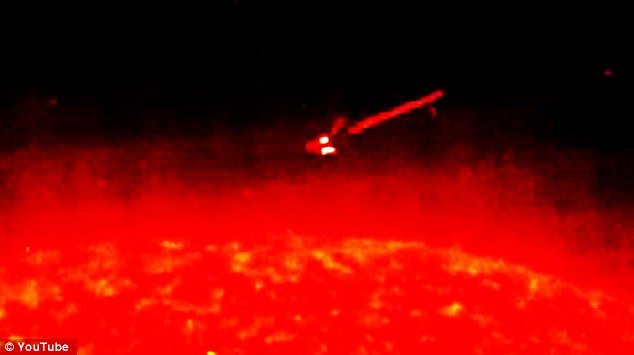
On May 5, “rob19791” posted a YouTube video of a mysterious-looking “object” hovering near the sun
One day later, NASA shut down the spacecraft’s video feed as it went into “emergency Sun reacquisition mode”.
“This is a cover up to prevent us from seeing these things again. NASA must have seen this video and started making plans to change the way you and I are allowed to view it,” he said in a second video.
“I think this is proof that NASA is covering this up.
“NASA is clearly trying to stop us looking at the sun,” he added.
This is the third time in recent months that believers have pointed out “proof” of UFOs based on supposedly unexplained phenomena on NASA’s space-monitoring equipment.
In December, a man says he found a “cloaked” space ship orbiting Mercury.
March brought the “Death Star”, a planet-size object seen “refueling” at the Sun – similar to rob19791’s triangular discovery.
In March, NASA scientists debunked the Death Star theory by explaining that cameras had simply captured a solar filament – a tunnel of matter extending out from the sun and cooling to form a dark “spot”.
It appears this might be the explanation for the second “UFO”, as well.
While the answer is shorter on conspiracy, it is no less puzzling to scientists.
They still aren’t sure what the filaments are or what caused them to form.
[youtube aTMAzhSN16I]
[youtube 4DBG8-58HVU]
Mid-Infrared Instrument (MIRI), one of Europe’s main contributions to the James Webb Space Telescope (JWST) is built and ready to ship to the US.
MIRI will gather key data as the $9 billion observatory seeks to identify the first starlight in the Universe.
The results of testing conducted at the Rutherford Appleton Laboratory in the UK have just been signed off, clearing MIRI to travel to America.
James Webb – regarded as the successor to Hubble – is due to launch in 2018.
It will carry a 6.5m primary mirror (more than double the width of Hubble’s main mirror), and a shield the size of a tennis court to guard its sensitive vision from the heat and strong light of our Sun.
The observatory has been tasked with tracking down the very first luminous objects in the cosmos – groupings of the first generation of stars to burst into life.
To do so, James Webb will use its infrared detectors to look deeper into space than Hubble, and further back in time – to a period more than 13 billion years ago.
“The other instruments on James Webb will do massive surveys of the sky, looking for these very rare objects; they will find the candidates,” explained MIRI’s UK principal investigator, Prof. Gillian Wright.
“But MIRI has a very special role because it will be the instrument that looks at these candidates to determine which of them is a true first light object. Only MIRI can give us that confirmation,” she said.
• James Webb’s main mirror has around seven times more collecting area than Hubble’s 2.4m primary mirror
• The sunshield is about 22m by 12m. There will be a 300-degree difference in temperature between the two sides
• James Webb’s instruments must be very cold to ensure their own infrared glow does not swamp the observations
• The mission will launch in 2018 on an Ariane rocket. The observing position will be 1.5 million km from Earth

Mid-Infrared Instrument (MIRI), one of Europe's main contributions to the James Webb Space Telescope (JWST) is built and ready to ship to the US
JWST is a co-operative project between the US (NASA), European (ESA) and Canadian (CSA) space agencies.
Europe is providing two of the telescope’s four instruments and the Ariane rocket to put it in orbit.
MIRI is arguably the most versatile of the four instruments, with a much wider range of detectable wavelengths than its peers (5-28 microns).
Fundamentally, it is a camera system that will produce pictures of the cosmos.
But it also carries a coronagraph to block the light from bright objects so it can see more easily nearby, dimmer targets – such as planets circling their stars. In addition, there is a spectrograph that will slice light into its component colors so scientists can discern something of the chemistry of far-flung phenomena.
MIRI is a complex design, and will operate at minus 266C. This frigid state is required for the instrument’s detectors to sample the faintest of infrared sources. Everything must be done to ensure the telescope’s own heat energy does not swamp the very signal it is pursuing.
The hardware for MIRI has been developed by institutes and companies from across Europe and America.
The job of pulling every item together and assembling the finished system has had its scientific and engineering lead in the UK.
MIRI has just gone through a rigorous mechanical and thermal test campaign at the Rutherford Appleton Laboratory (RAL) in Oxfordshire.
This included shaking the instrument to simulate the pounding it will receive during the ascent to orbit on the Ariane.
It was also put in a vacuum chamber and subjected to the kind of temperatures it will experience in space.
“It’s been a real privilege to work on MIRI and great to see it finally ship out,” said Paul Eccleston, the engineer at RAL who has overseen the test campaign.
“It will be so exciting when we put it on top of the rocket and light the blue touch paper, so to speak, and watch it go up into space.”
The paperwork signing off the test results has now been accepted by NASA.
The next step is for MIRI to be put in a special environment-controlled shipping box, so it can travel to the US space agency’s Goddard centre. The Maryland facility is where the final integration of James Webb will take place.
MIRI will be fixed inside a cage-like structure called the Integrated Science Instrument Module and positioned just behind the big mirror.
The years to 2018 promise yet more testing.
• James Webb’s instruments will be tuned to light beyond the detection of our eyes – at near- and mid-infrared wavelengths
• It is in the infrared that very distant objects will show up, and also those objects that in the visible range are obscured by dust
• Hubble is a visible light telescope with some near-infrared capability, but its sensitivity will be dwarfed by JWST’s technologies
• Europe’s far-infrared Herschel space telescope has a bigger mirror than Hubble, but JWST’s mirror will be larger still
Recommended 16 years ago as the logical evolution beyond Hubble, the JWST has managed to garner a fair amount of controversy.
Technical difficulties and project mismanagement mean the observatory is now running years behind schedule and is billions of dollars over-budget.
Elements of the US Congress wanted to cancel the telescope last summer. That did not happen, but Capitol Hill now has James Webb on a very short leash, with NASA required to provide monthly updates on milestones met or missed.
Much of the talk around James Webb tends to centre on cost. The current estimate for the US side is $8.8 billion, which covers the full life cycle of the project from its inception to the end of initial operations. Extra to that bill is some $650 million for the European contributions like MIRI and Ariane.
Dr. Eric Smith is NASA’s deputy programme director for James Webb. He believes taxpayers do appreciate the venture.
“When you’re able to show people that James Webb will do things that not even Hubble can do – then they understand it,” he said.
“People recognize how iconic Hubble has been, and how much it has affected their lives.
“The images and scientific results that Hubble has returned have permeated popular culture. Webb pictures will be just as sharp but because the telescope will be looking at a different part of the spectrum, it will show us things that are totally new.”
Enterprise, NASA’s original prototype for the space shuttle program, took to the skies today for the first time in nearly 27 years for a historic sky show above the Manhattan skyline.
Secured to the top of a modified 747 Boeing jetliner, Enterprise took off on Friday morning from Dulles International Airport in Virginia for New York, where it landed just under two hours later at John F. Kennedy International Airport in Brooklyn.
On the way, it thrilled thousands of spectators by flying at low-attitude above some of Manhattan’s most iconic landmarks, including the Statue of Liberty, the Empire State Building and One World Trade Center, as it followed the Hudson River to the Tappan Zee Bridge and back.
The spectacle is part of the space agency’s process of wrapping up the shuttle program and comes just ten days after Space Shuttle Discovery soared over the Washington Monument, White House and the Capitol before landing at Dulles International Airport in Virginia.
Crowds gathered at JFK Airport in anticipation of the arrival. Spectators flocked to piers along the Hudson River, to the harbor at Battery Park and scrambled onto roof tops for the best views as the shuttle approached the skyline at 10:30 a.m.
Enterprise was chased through the air by a NASA plane and by numerous ferries and other boats zooming along the Hudson. Photographs capture the moment it soared over landmarks including the Statue of Liberty and the Rockefeller Center and parts of the city, such as Long Island and Staten Island.
“There it goes: Space Shuttle Enterprise flying over,” staff at the Lincoln Center tweeted.
“An amazing view!”
It had been scheduled to fly on Monday and then again on Wednesday but NASA pushed the journey back due to bad weather. Fears of strong winds did not deter the flight on Friday and it took off on time at 9:39 a.m.
Enterprise landed at John F. Kennedy International Airport to cheers from thousands of spectators – including school children from New York, New Jersey and Connecticut – shortly after 11:20 a.m.
“Touchdown at JFK!” NASA declared on Twitter.
At the Kennedy tower, air traffic controllers had been busy fielding inquiries from pilots circling in other planes. They were told their planes would be delayed from landing because of “special activity”.
As the Boeing and its auspicious cargo landed, the controller said to the shuttle craft: “Welcome to New York, and thanks for the show.”

Enterprise took to the skies today for the first time in nearly 27 years for a historic sky show above the Manhattan skyline
Now there, it will be removed from the jetliner. In June, it will be transported by barge up the Hudson River to its final resting place – Manhattan’s Intrepid Sea, Air and Space Museum on the city’s west side.
It will be “the largest and most significant space artifact in the Northeast”, according to said Susan Marenoff-Zausner, the museum’s president.
She told CNN: “It is so exciting for school trips, for universities and other people we partner with. We’re so excited we now has this representation in the Northeast. It is the largest NASA artifact north of Baltimore.”
Visitors viewed the shuttle’s flight across the city from a vantage point at the Intrepid, a converted aircraft carrier used in World War II. The museum also invited 1,500 special guests to see the landing at the airport, including New York state and local elected officials.
Enterprise will be transported to the museum by barge in June and the museum expects to open its exhibit in mid-July.
“When somebody comes to visit, they will not only see the shuttle itself, but will have an engaging and interactive experience inside the pavilion,” Susan Marenoff-Zausner told the Associated Press.
NASA’s shuttle program ended last summer. After its flight two weeks ago, Discovery will take Enterprise’s place at the Smithsonian. Shuttle Endeavor will fly to Los Angeles, California and shuttle Atlantis is remaining at Florida’s Kennedy Space Center.
Unlike these other crafts, Enterprise has never been used in a space mission but was a prototype used to test atmosphere and for experiments on the ground. It was rolled out in December 1976 and was crucial to the development of the shuttle program before the agency launched Discovery in 1981.
Enterprise was originally going to be named the Constitution, but a campaign staged by fans of the 1960s sci-fi television series Star Trek persuaded officials to name it after the show’s fictional starship. A photograph taken shortly after shows the cast posing in front of the shuttle.
While Enterprise was constructed without engines or a suitable heat shield, it did fly in 1977 – after it was mounted to the top of a NASA 747, similar to the flight it will take over New York City today.
After carrying out tests throughout the late 1970s and early 1980s, Enterprise retired and some of its parts were used in other shuttles.
NASA sent Enterprise on a tour of Europe and Canada in 1983. It made a brief return to service as a ground test vehicle in 1984 and finally retired in November 1985 when it was transported to Washington D.C. and became part of the Smithsonian Institution.
Susan Marenoff-Zausner said the fact the shuttle has never been on a mission does not make it any less exciting.
“This is an institution in American history,” she said.
“This tested so many different things that without it, travel into space would never have happened.”
She believes interest in the shuttle will increase the number of annual visitors by 30%, to 1.3 million over the year.
Once at the museum, the Enterprise will be hoisted by crane to a deck. The museum is housed at a 900-foot-long aircraft carrier that was used during World War II and the Vietnam War and also served as a recovery vessel for NASA’s space program.
The U.S. retired its space shuttles last year after finishing construction of the $100 billion International Space Station to begin work on a new generation of spaceships that can carry astronauts to destinations beyond the station’s 240-mile-high orbit, Reuters reported.
NASA has been flying the shuttles to cities around the nation for display.
There had been a squabble over where Enterprise would be exhibited, with the Space Center in Houston, Texas making a bid for the shuttle. Yet NASA’s decision was based upon maximum exposure for the craft, CNN reported, meaning they were swayed by bids from New York, Florida and California.
[youtube oL1wXHTNuIw]
[youtube PeNqUAL2hbs]
The Sun had a massive solar explosion on April 16th.
A coronal mass ejection (CME) is a massive burst of solar wind, other light isotope plasma, and magnetic fields rising above the solar corona or being released into space.
Coronal mass ejections are often associated with other forms of solar activity, most notably solar flares, but a causal relationship has not been established. Most ejections originate from active regions on Sun’s surface, such as groupings of sunspots associated with frequent flares. Near solar maxima the Sun produces about three CMEs every day, whereas near solar minima there is about one CME every five days.
A beautiful prominence eruption shot off the east limb (left side) of the sun on Monday, April 16, 2012. Such eruptions are often associated with solar flares, and in this case an M1 class (medium-sized) flare did occur at the same time, though it was not aimed toward Earth. This event was seen by NASA’s SDO satellite.
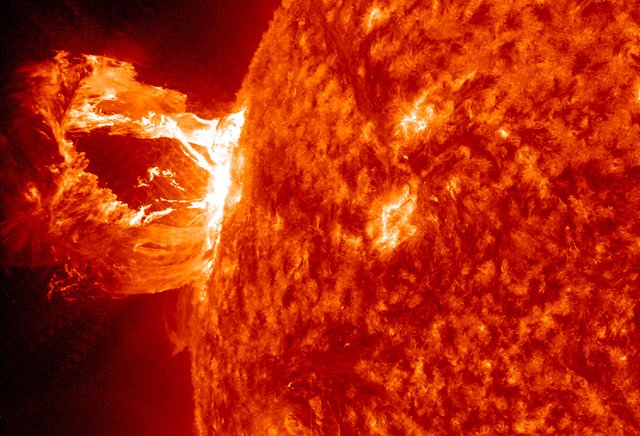
“A large CME can contain a billion tons of matter that can be accelerated to several million miles per hour in a spectacular explosion. Solar material streams out through the interplanetary medium, impacting any planet or spacecraft in its path,” explains NASA, who told us that this particular blast reached to the far end of our solar system.
NASA’s Karen Fox said the “height” of the CME (from our perspective) was “25 earth radii high”—198,000 miles.
HD Video of the solar explosion:
[flickr 7084820027 640 480]
Find out more photos from NASA by clicking here
Scientists claim that spacecrafts could one day navigate through the cosmos using a particular type of dead star as a kind of GPS.
German scientists are developing a technique that allows for very precise positioning anywhere in space by picking up X-ray signals from pulsars.
These dense, burnt-out stars rotate rapidly, sweeping their emission across the cosmos at rates that are so stable they rival atomic clock performance.
This timing property is perfect for interstellar navigation, says the team.
If a spacecraft carried the means to detect the pulses, it could compare their arrival times with those predicted at a reference location. This would enable the craft to determine its position to an accuracy of just five kilometres anywhere in the galaxy.
“The principle is so simple that it will definitely have applications,” said Prof. Werner Becker from the Max-Planck Institute for Extraterrestrial Physics in Garching.
“These pulsars are everywhere in the Universe and their flashing is so predictable that it makes such an approach really straightforward,” said Prof. Werner Becker.
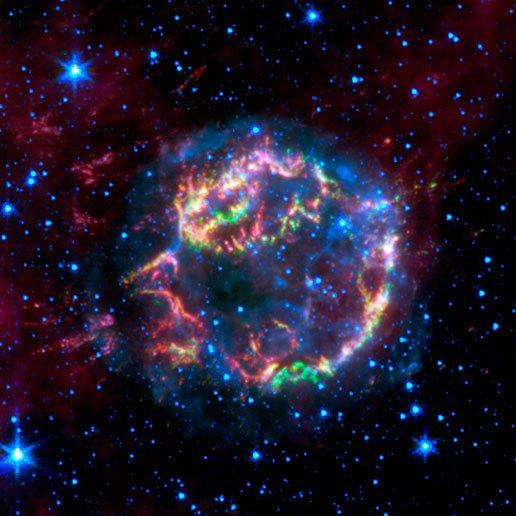
Spacecrafts could one day navigate through the cosmos using a particular type of dead star as a kind of GPS
Prof. Werner Becker has been describing his team’s research here at the UK National Astronomy Meeting in Manchester.
The proposed technique is very similar to that employed in the popular Global Positioning System, which broadcasts timing signals to the user from a constellation of satellites in orbit.
But GPS only works on, or just above, the Earth so it has no use beyond our planet.
Currently, mission controllers wanting to work out the position of their spacecraft deep in the Solar System will study the differences in time radio communications take to travel to and from the satellite. It is a complex process and requires several antennas dotted across the Earth.
It is also a technique that is far from precise, and the errors increase the further away the probe moves.
For the most distant spacecraft still in operation – NASA’s Voyager satellites, which are now approaching the very edge of the Solar System, some 18 billion km away – the errors associated with their positions are on the order of several hundred kilometers.
Even for a probe at the reasonably short separation of Mars, the positioning uncertainty can be about 10 km.
It is unlikely though that navigation by pulsar beacon will find immediate use.
The telescope hardware for detecting X-rays in space has traditionally been bulky and heavy.
Engineers will need to miniaturize the technology to make a practical pulsar navigation unit.
“It becomes possible with the development of lightweight X-ray mirrors,” said Prof. Werner Becker.
“These are on the way for the next generation of X-ray telescopes. Current mirrors have a 100 times more weight and would be completely unusable.
“In 15-20 years, the new mirrors will be standard and our device will be ready to be built.”
The scientist believes his navigation solution will certainly find use on Solar System probes, providing autonomous navigation for interplanetary missions and perhaps for future manned ventures to Mars where high performance systems will be an absolute requirement for safety reasons.
But he also likes the idea of humanity one day pushing out across interstellar space.
“You know for GPS that if you go to another country, you have to buy the maps for your device. Well, we were joking with our students in Garching about selling maps for different galaxies for ships like Enterprise [on Star Trek].”
Finland-based Rovio Entertainment, the creator of the Angry Birds franchise, has announced its newest game ”Angry Birds Space”, which was developed in cooperation with NASA.
For nearly 3 years, millions of gamers have used physics in the battle between birds and pigs in the video game Angry Birds.
NASA and Rovio are working together to teach people about physics and space exploration through the internationally successful puzzle game.
Game developers have incorporated concepts of human space exploration into the new game. From the weightlessness of space to the gravity wells of nearby planets, players use physics as they explore the various levels of the game set both on planets and in microgravity.
“This collaboration began with a simple Twitter exchange about birds and pigs in space, and it has grown into a tremendous outreach and education opportunity,” said David Weaver, associate administrator for communications at NASA Headquarters in Washington.
“Games are fun and entertaining, but they also can be inspirational and informative. This ongoing collaboration with Rovio and Angry Birds is an exciting way to get people engaged with NASA’s missions of exploration and discovery, and get students energized about future careers in science and technology.”

Rovio Entertainment, the creator of the Angry Birds franchise, has announced its newest game ”Angry Birds Space”, which was developed in cooperation with NASA
Aboard the International Space Station, Flight Engineer Don Pettit of NASA created a video using Angry Birds Space to explain how physics works in space, including demonstrating trajectories in microgravity by catapulting an Angry Bird through the space station. The video was shown this week to an audience at the South by Southwest Conferences and Festivals, an annual convention of original music, independent films, and emerging technologies in Austin, Texas. It is also available on NASA’s website at http://www.nasa.gov.
“We focused on every detail in development of Angry Birds Space to build a special experience for our fans,” said Peter Vesterbacka, chief marketing officer and mighty eagle of Rovio Entertainment.
“I believe we have succeeded well with the game, and we wanted to create something as unique around our launch events. NASA has been the perfect partner for our Angry Birds Space program, and we can’t wait to work with them on creating more compelling educational experiences.”
[youtube lxI1L1RiSJQ]
Startram is a proposed “space train” that could make cheaper journeys beyond Earth’s atmosphere and will allow 4 million people a year to travel to space by 2032, according to its designers.
Startram, designed by one of the inventors of the “magnetic levitation” trains in use in countries such as China, would be a railway driven by superconducting cables suspended in the air by magnetic forces.
Trains would shoot to orbit in seconds in an 80-mile sealed tube – and the scientists behind the $60 billion proposal claim it could revolutionize industry, allowing for cheap space-based solar power and generating unimaginable wealth from mines on asteroids.
“Startram is based on existing maglev technology and basic physics. A motivated nation could build a startram system capable of launching 300,000 tons of payload into orbit for less than $40/kg,” say the space train’s creators.
The system would “shoot” capsules into orbit, accelerating a sealed cargo capsule to a speed of 5 miles per second at 30G using high-powered electromagnets.
“The resources of our own solar system are vast. The energy from the Sun hitting our small planet everyday is roughly 10,000 times our current energy needs. The raw materials locked up in asteroids and comets could support economic growth for millennia to come,” say the scientists.
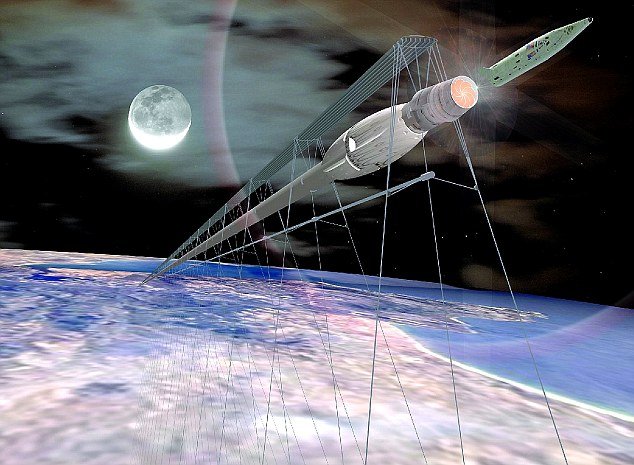
Startram is a proposed “space train” that could make cheaper journeys beyond Earth's atmosphere and will allow 4 million people a year to travel to space by 2032
Startram’s creators say that it would be the “next great step” for human civilization – and would provide a “safety net” if life on Earth was threatened by wars or disaster.
“A cargo-only version would cost on the order of $20 billion to build and could be completed within 10 years. A people-capable version could be built for $60 billion and be completed within 20 years,” say Startram’s designers, physicists including Dr. James Powell, the co-inventor of “maglev” train systems.
NASA scientists have looked into the technology and pronounced it feasible.
“Human beings are at the dawn of a new age. Either we will become a true spacefaring people, or we will be trapped on an overcrowded, strife-ridden planet with ever-dwindling resources,” say Startram’s creators.
However, the physicists warn: “Startram will necessarily be an international program, otherwise the potential for a expensive and dangerous arms race between nations is too great. Therefore, the must come from you, the people. This is simply too important to leave up to individual nations and militaries.”
Paul K. Martin, NASA’s inspector general, has told US lawmakers that hackers gained “full functional control” of key agency’s computers in 2011.
Paul K. Martin said hackers took over Jet Propulsion Laboratory (JPL) computers and “compromised the accounts of the most privileged JPL users”.
He said the attack, involving Chinese IP addresses, was under investigation.
In a statement, NASA said it had “made significant progress to protect the agency’s IT systems”.
Paul K. Martin’s testimony on NASA’s cybersecurity was submitted to the House Committee on Science, Space and Technology’s Subcommittee on Investigations and Oversight.
In the document, he outlined how investigators believed the attack had involved “Chinese-based internet protocol [IP] addresses”.
He said that the attackers had “full system access” and would have been able to “modify, copy, or delete sensitive files” or “upload hacking tools to steal user credentials and compromise other NASA systems”.
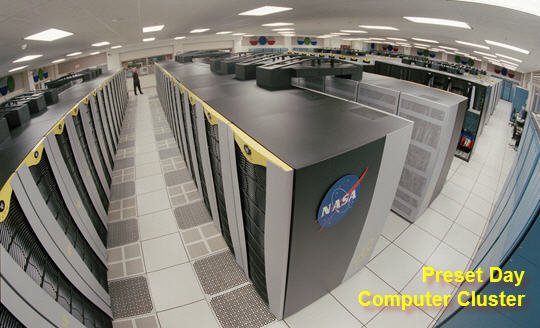
Paul K. Martin, NASA's inspector general, has told US lawmakers that hackers gained "full functional control" of key agency’s computers in 2011
Paul K. Martin outlined how the agency suffered “5,408 computer security incidents” between 2010 and 2011.
He also noted that “between April 2009 and April 2011, NASA reported the loss or theft of 48 Agency mobile computing devices”.
In one incident an unencrypted notebook computer was lost containing details of the algorithms – the mathematical models – used to control the International Space Station.
NASA said that “at no point in time have operations of the International Space Station been in jeopardy due to a data breach”.
Paul K. Martin said NASA was a “target-rich environment for cyber attacks”.
He said that the motivation of the hackers ranged from “individuals testing their skill to break into NASA systems, to well-organized criminal enterprises hacking for profit, to intrusions that may have been sponsored by foreign intelligence services”.
But while Paul K. Martin criticized aspects of NASA’s cybersecurity he noted investigations had resulted in “arrests and convictions of foreign nationals in China, Great Britain, Italy, Nigeria, Portugal, Romania, Turkey, and Estonia”.
NASA said it was working to implement the security improvements Paul K. Martin suggested in his testimony.
However the chairman of the congressional subcommittee, Rep. Paul Broun, quoted in an online report of proceedings, said: “Despite this progress, the threat to NASA’s information security is persistent, and ever changing. Unless NASA is able to constantly adapt – their data, systems, and operations will continue to be endangered.”
A new NASA-funded university study based on satellite data has found that Earth’s clouds got a little lower by around 1% cent a year on average during the first decade of this century.
The results have potential implications for future global climate.
Scientists at the University of Auckland in New Zealand analyzed the first 10 years of global cloud-top height measurements (from March 2000 to February 2010) from the Multi-angle Imaging SpectroRadiometer (MISR) instrument on NASA’s Terra spacecraft.
The study, published recently in the journal Geophysical Research Letters, revealed an overall trend of decreasing cloud height. Global average cloud height declined by around 1% over the decade, or by around 100 to 130 feet.
Most of the reduction was due to fewer clouds occurring at very high altitudes.

Earth's clouds got a little lower by around one percent cent a year on average during the first decade of this century
Lead researcher Roger Davies said that while the record is too short to be definitive, it provides a hint that something quite important might be going on. Longer-term monitoring will be required to determine the significance of the observation for global temperatures.
A consistent reduction in cloud height would allow Earth to cool more efficiently, reducing the surface temperature of the planet and potentially slowing the effects of global warming.
This may represent a “negative feedback” mechanism – a change caused by global warming that works to counteract it.
“We don’t know exactly what causes the cloud heights to lower,” says Roger Davies.
“But it must be due to a change in the circulation patterns that give rise to cloud formation at high altitude.”
NASA’s Terra spacecraft is scheduled to continue gathering data through the remainder of this decade. Scientists will continue to monitor the MISR data closely to see if this trend continues.
Solar Dynamics Observatory, a NASA satellite, captured amazing pictures of a gigantic tornado moving across the sun.
The tornado is larger than it might look – in fact, it is probably bigger than the Earth, and could extend hundreds of thousands of miles out into space.
And while its progress over the sun’s surface seems almost stately, it is moving at 300,000 miles per hour.
The extraordinary phenomenon – which cannot yet be fully explained by scientists – was filmed by NASA’s Solar Dynamics Observatory (SDO) over a 30-hour period earlier this month.
That satellite, known as the SDO, is in the middle of a five-year mission to monitor how solar activity affects the Earth, particularly changes in the sun’s magnetic field.

Solar Dynamics Observatory, a NASA satellite, captured amazing pictures of a gigantic tornado moving across the sun
While the tornado – called a “solar prominence” by scientists – looks very similar to twisters here on Earth, its origins are completely different.
Rather than being the result of atmospheric pressure, the solar activity comes from fluctuations in the sun’s magnetism.
However, researchers cannot explain much more than that – NASA’s Terry Kucera told Fox News that she and her colleagues were “still looking to understand what’s happening with these things”.
The tornado, at 15,000 degrees Fahrenheit (8,000 C), is much cooler than its surroundings, which are around 2 million degrees.
The phenomenon was not caught on camera until 1996.
[youtube r-zt8qnTcLM]
NASA looks set to pull the plug on its joint missions to Mars with the European Space Agency (ESA), ExoMars programme.
NASA has told ESA it is now highly unlikely it will be able to contribute to the endeavors, which envision an orbiting satellite and a big roving robot being sent to the Red Planet.
The US has yet to make a formal statement on the matter but budget woes are thought to lie behind its decision.
Europe is now banking on a Russian partnership to keep the missions alive.
A public announcement by NASA of its withdrawal from the ExoMars programme, as it is known in Europe, will probably come once President Barack Obama’s 2013 Federal Budget Request is submitted.
This request, expected in the coming days, will give NASA a much clearer view of how much money it has to implement its various projects.
“The Americans have indicated that the possibility of them participating is now low – very low. It’s highly unlikely,” said Alvaro Gimenez, ESA’s director of science.
“They are interested, they know it’s a very good option for them – but they have difficulties putting these missions in the budget,” he said.
“We have to wait for the Americans to have a definitive say, but we also have to study alternatives.”

A public announcement by NASA of its withdrawal from the ExoMars programme, as it is known in Europe, will probably come once President Barack Obama's 2013 Federal Budget Request is submitted
The pull-out by NASA – if that is confirmed – will be just the latest twist in what has been a long running saga, and it will leave Europe’s Mars ambitions in a precarious position.
As currently planned, ExoMars would see an orbiting satellite launched in 2016 to “sniff” for methane and other trace gases in the Martian atmosphere, followed by an autonomous rover in 2018 to drill beneath the planet’s surface.
The Americans were supposed to be providing instruments and a communications package for the orbiter, and a great swathe of equipment for the rover, in addition to the rocket to send it on its way and the descent system to get the robot safely down on to the Martian terrain.
Concerns last year in the US about the state of NASA’s Mars budget had already prompted ESA to inquire whether the Russian space agency (Roscosmos) would be interested in entering the ExoMars programme.
But the latest signals from Washington have now pushed ESA into discussing a full bi-lateral agreement, with the intention that Roscosmos pick up many of the responsibilities expected to be dropped by the Americans.
This would include instruments for the orbiter and the provision of two Proton rockets to get both missions to their destination.
It could not be a straight substitution of roles, however, because the Russians do not possess all of the skills that NASA was proposing to bring to ExoMars.
For Europe, it means returning to an earlier, smaller design for the 2018 rover. It would also have to resurrect ideas it had for vented, or dead-beat, airbags to cushion the vehicle’s touch-down.
But the technical challenges of having to reframe the ExoMars missions may pale in comparison to the difficulties of meeting the additional costs involved.
Changes in architecture would inevitably push the budget profile beyond the one billion Euros that ESA member states had agreed should be the cap for ExoMars.
“I cannot pretend the situation is not grim,” commented Dr. David Parker, director of science, technology and exploration at the UK Space Agency (UKSA).
“It’s come as a major surprise to us that the Americans don’t want to play. We now have to take some cold, sensible decisions about what we do with public money, and it may be that some national activities will have to be put in the deep freeze until we have a clearer sense of what is going to happen.”
ExoMars was formally initiated in Europe by ministers in 2005. ESA has already spent in the region of 200 million Euros on technology development, and would be loath to give up on the flagship project.
“ExoMars is really important for Europe and its role in future exploration,” said Dr. Gimenez.
“It’s important for science and it’s important for industry. There are a host of reasons to continue with ExoMars and that is why I am working so hard to try to make it happen,” he added.
A NASA pull-out of ExoMars would be met with dismay by American planetary scientists.
The 2016 and 2018 missions were seen as the first steps in a series of missions that would lead to the eventual return of Martian rocks for study in Earth laboratories.
A recent panel reviewing the future of US planetary science considered this goal to be a top priority.
Withdrawal also has grave implications for transatlantic relations.
The US has already left Europe high and dry on several projects of late. Last year, it walked away from three multi-billion euro missions-in-the-planning, forcing European scientists and engineers to head back to the drawing board after three years of feasibility work.
NASA announces that an asteroid the size of a bus is set to pass extremely close to Earth today.
Asteroid 2012 BX34 will pass within 36,750 miles of Earth at about 3:30 p.m GMT/10:30 a.m. EST Friday, January 27, tweeted astronomers with NASA’s Asteroid Watch program.
Even though this is more than five times closer than the moon, at 11 meters wide, the rock won’t be any threat to Earth.
“It wouldn’t get through our atmosphere intact even if it dared to try,” Asteroid Watch scientists tweeted Thursday.
Asteroid Watch is a part of NASA’s Jet Propulsion Laboratory in Pasadena, California.
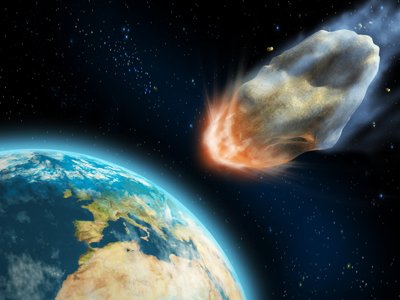
NASA announces that an asteroid the size of a bus is set to pass extremely close to Earth today
For an asteroid to cause real damage to Earth, it needs to measure at least 140 m, experts estimate.
At that size they can cause widespread destruction near where they hit but will need to be far larger to cause trouble globally.
With this danger in mind, scientists in Germany have just launched a study to develop an asteroid shield.
With funds from the European Commission, the NEOShield project is expected to take three years to complete.
Some of the scientists will look at include repelling asteroids with projectiles or explosives or using gravity to change its course.
Still today’s asteroid passing should offer a good show:
“Advanced amateur astronomers might be able to observe the flyby as the asteroid brightens to 14th magnitude just before closest approach on Friday,” the website Spaceweather.com reported.
On December 21, 2012, the apocalypse foretold 5,125 years ago by the ancient Mayans will come to pass and the world will end.
Meanwhile, Harold Camping, an American radio preacher, got thousands of followers worked up when he predicted the Second Coming of Jesus Christ on May 21 last year.
When that didn’t happen, Harold Camping said the world would end on October 21. And then he quietly retired from his radio show.
But the “2012 phenomenon”, as it is commonly known to its legions of internet followers, is different.
For the Mayans, a famously wise and advanced civilization which was at its height between 250 and 900AD in the present-day Mexican state of Yucatan and Guatemala, have grabbed everyone’s attention.
The evidence boils down to one simple fact: their 5,125-year calendar – the one used across Central America before the arrival of Europeans – runs out on December 21 this year.
The point is that the Mayans were noted for their extraordinary astronomical observations and mathematical powers.
And if they didn’t think it worth taking their calendar beyond December 2012, they must have had a reason.
Public concern is so high that NASA, the U.S. space agency, even has a section debunking the theories of impending doom on its website.
NASA says it has taken more than 5,000 questions from people, some asking if they should kill themselves, their families or their pets.
Archaeologists who have studied the Mayans have been downplaying the apocalypse theories, insisting that the only surviving Mayan reference to any dreadful significance attached to December 21, 2012, was contained on a single ancient stone tablet found at ruins in Tortuguero, southern Mexico, in the 1960s.

Mexico’s tourism agency hopes the 2012 phenomenon will draw 52 million visitors to the region - more than twice the number the whole country normally receives
According to an inscription on the tablet, a fearsome Mayan god of war and creation may “descend” from the sky on the appointed day.
But then, a few weeks ago, archaeologists had to admit they had found a second piece of evidence – a 1,300-year-old carved brick fragment at a temple ruin in nearby Comalcalco.
The brick, now kept in a vault at Mexico’s National Institute of Anthropology and History, has an inscription on its face which also refers to the date.
The fact that the face of the brick was probably laid facing inward or covered with stucco – suggesting it was not meant to be seen by the Mayan population who visited the temple – has only added to the hysteria of modern doom-mongers.
Scientists insist there is no dire threat on the horizon, while Mayan experts stress that the ancient civilization’s legacy has simply been misinterpreted.
“Nothing bad will happen to the Earth in 2012,” says NASA on its website in the reassuring tones of a parent dealing with a frightened toddler.
“Our planet has been getting along just fine for more than four billion years, and credible scientists worldwide know of no threat associated with 2012.”
Of course in these conspiracy-obsessed times, there are thousands of cynics who are not convinced.
David Morrison, senior scientist at the NASA Astrobiology Institute, said he had been receiving about ten emails a day from worried members of the public who are “seriously, seriously upset”.
A young woman from Denmark wrote to him saying: “Mother of one daughter and another coming.
“Yesterday I was considering killing myself, the baby in my stomach and my beloved two-year-old daughter before December 2012 for fear of having to experience the Earth’s destruction.”
A 13-year-old American, wrote: “I am considering suicide. I am scared to tears . . . I don’t want to live any more, I deserve an explanation.”
Another wrote: “I am so scared. My only friend is my little dog. When should I put her to sleep so she won’t suffer when the Earth is destroyed?”
Worried Americans are rushing to buy everything from $27 survival guides to $50,000-per-person places in bunkers that are marketed as being both nuclear bomb and asteroid-proof.
Robert Vicino, a Californian businessman who is building the luxury bunkers in secret locations asked on his website: “What if the prophecies are true? Which side of the door do you want to be on?”
The businessman says that he has more than 5,000 Americans booking places, and is now building bunkers in Europe.
Steve Cramer, one man who has reserved his place, insists: “We’re not crazy people: these are fearful times. My family wants to survive. You have to be prepared.”
Jason Hodge, a father-of-four who also counts himself a “future survivor”, to use the jargon of the apocalypse industry, adds: “It’s an investment in life.
“I want to make sure I have a place I can take me and my family if that worst-case scenario were to happen.”
Mayan apocalypse converts have started flocking to Bugarach too, a tiny hilltop town in the foothills of the Pyrenees.
The 200-strong local community has had to contend with 20,000 visitors since the start of last year, and the French government is worried about the threat of mass suicides.
Believers say a magnetic force surrounds the town’s “mystical” mountain where the top layers of rock are older than the lower ones.
(Geologists say that soon after the mountain was formed, it exploded and the top flew into the air, before landing upside-down).
People claim the magnetic force will protect them from the apocalypse to come.
Others who have flocked to Bugarach insist the mountain is a gateway to another dimension and may contain a secret alien base.
Unhelpfully, the Mayans did not specify exactly what would happen when the world ends. But that hasn’t stopped believers from letting their imaginations run riot.
Many of their 2012 doomsday scenarios involve astronomical phenomena – a rogue planet hitting Earth, fierce solar storms, a galactic alignment in which the Sun’s gravitational effect combines with that of a huge black hole to create havoc. The gloomiest think we may get all three.
A particularly popular theory is that a rogue planet called Nibiru is lurking behind the Sun and will collide with the Earth next December, destroying it. Some believe this rogue body is Eris, a dwarf planet orbiting beyond Neptune.
The idea of a planet creeping out from behind the Sun and smashing into Earth provided the depressing backdrop to last year’s Lars von Trier film Melancholia, starring Kirsten Dunst and Kiefer Sutherland.
Another theory, also involving the Sun, predicts that a huge solar flare – called a “solar max” – will destroy the Earth.
This notion has already inspired Hollywood in the 2009 disaster blockbuster 2012, in which the flare caused catastrophic earthquakes. The film also made reference to the Mayan calendar.
Finally, no apocalypse would be complete without at least one alien invasion.
This time last year, reports emerged suggesting the U.S. Search For Extraterrestrial Intelligence Institute (SETI) had detected three large spacecraft due to arrive at Earth in 2012. SETI rejected the claims, to which those who wanted to believe the reports replied: “Well they would, wouldn’t they?”
Another alien theory doing the rounds among conspiracy theorists is that the authorities will stage a fake extra-terrestrial invasion at next year’s closing ceremony for the London Olympic Games so they can declare martial law and introduce a new world order.
Academics and scientists dismiss all of these theories as wild hysteria, of course.
But the fact is that Mayan scholars have been bickering for years over what the end of the Long Count Calendar actually signifies.
The Mayan calendar began in 3,114 BC – believed by Mayans to be when the current “world order” was created – and progresses in 144,000-day cycles (a little more than 394 years) known as baktuns.
The 13th (a sacred number for Mayans) baktun runs out on the 2012 winter solstice, December 21. After that date, the “Great Cycle” is completed and the calendar sequence simply ends.
In 1957, respected Mayan scholar and astronomer Maud Worcester Makemson wrote that the completion of a “Great Period” of 13 baktuns would have been “of the utmost significance to the Maya”.
In 1966, Michael Coe, another prominent Mayan anthropologist and a former CIA agent, went much further and concluded there was a “suggestion” among the Mayans that the final day of the Great Cycle would see “Armageddon overtake the degenerate peoples of the world and all creation” and “thus . . . our present universe would be annihilated”.
Experts had tended to agree with Michael Coe’s interpretation until about a decade ago when the academic world started to insist the Mayans had meant nothing of the sort.
The Mayans believed the end of the 13th baktun would indeed be significant, say academics now, but in a good way.
There will simply be another cycle and it will be a cause for celebration not desperation.
This optimistic message has been championed by many in the New Age movement, which is obsessed by the idea that cultures such as the Mayans had a secret spiritual knowledge that we might tap into if only we knew where to look.
Whatever the truth, hundreds of books have already been published on the subject, not to mention dozens of television programmes and films.
For the most reliable indication of the future, we should perhaps head for the heart of Mayan territory in south-eastern Mexico.
There, locals aren’t running for the hills at all, and don’t seem worried.
In fact, quite the reverse. After suffering years of a tourist industry badly hit by the violence of warring drug cartels, they are looking forward to an economic boom.
Mexico’s tourism agency hopes the 2012 phenomenon will draw 52 million visitors to the region – more than twice the number the whole country normally receives.
And the town of Tapachula, on the Guatemalan border, has already started a countdown to December 21 on a giant digital clock in its main park.
Quite what will happen on the day it runs out remains the subject of feverish debate around the world.
NASA has succeeded in putting the first of twin gravity mapping satellites (Gravity Recovery and Internal Laboratories) in orbit around the Moon.
The Grail-A spacecraft fired its main engine late on Saturday (GMT) to slow itself sufficiently to take up an elliptical path around the lunar body.
The twin Grail-B, will attempt exactly the same maneuver on Sunday.
Together, the satellites will make measurements that are expected to give scientists remarkable new insights into the internal structure of the Moon.
This new data should clarify ideas about the Moon’s formation and resolve many questions, such as why its near and far sides look so different.
Lead scientist Dr. Maria Zuber from the Massachusetts Institute of Technology (MIT) is hoping for some dramatic discoveries.
“My resolution for the new year is to unlock lunar mysteries and understand how the Moon, Earth and other rocky planets evolved,” she said.
“Now, with Grail-A successfully placed in orbit around the Moon, we are one step closer to achieving that goal.”
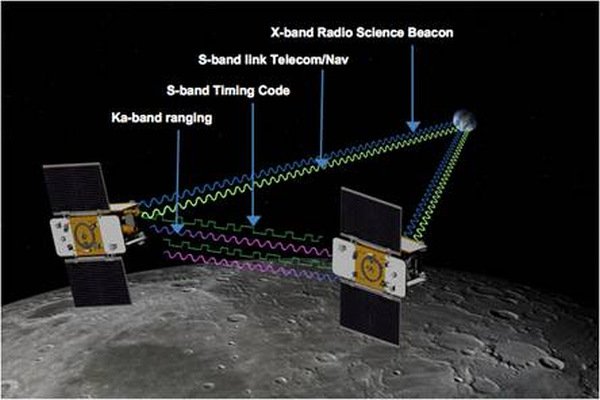
NASA’s twin Grail satellites will make measurements that are expected to give scientists remarkable new insights into the internal structure of the Moon
The twin satellites were launched from Cape Canaveral, Florida, last September, and took a long spiral out to their destination.
This weekend’s approach to the Moon was designed to bring them in over the South Pole.
Grail-A, which is running ahead of its twin, initiated its orbit insertion manoeuvre at 21:21 GMT with a 40-minute burn on its 22-newton thruster.
Grail-B is programmed to make an almost identical burn on Sunday, starting at 22:05 GMT. NASA should have confirmation shortly before 23:00 GMT on New Year’s Day that both satellites are in the positions they should be.
“Following the lunar orbit insertion, the spacecraft will perform a series on intricate burns that take about two months, and these are required to get both spacecraft down to a [55km; 34-mile] altitude; and once that’s done, that’s when the science for Grail can begin,” explained David Lehman, the mission’s project manager at the Jet Propulsion Laboratory (JPL) in California.
Grail will map the small variations in gravity across the Moon.
These differences are the result of an uneven distribution of mass. Obvious examples at the Moon’s surface include big mountain ranges or deep impact basins, but even inside the lunar body the rock will be arranged in an irregular fashion, with some regions being denser than others.
All this will have a subtle influence on the pull of gravity sensed by over-flying spacecraft.
The Grail twins will make their measurements by carrying out a carefully calibrated pursuit of each other.
As the lead spacecraft flies through the uneven gravity field, it will experience small accelerations or decelerations. The second spacecraft, following some 100-200km behind, will detect these disturbances as very slight changes in the separation between the pair – deviations that are not much more than the width of a human red blood cell.
When the gravity map is combined with comparable-resolution topographical information showing the surface highs and lows, scientists should be able to deduce the Moon’s probable internal structure and composition. This is fundamental knowledge that will play into theories of how the lunar body formed and how it has evolved over time.
“We believe the Moon formed from the impact of a Mars-sized object into Earth, but we understand little really of how this happened and how the [lunar body] cooled off after the violent event,” said Dr. Maria Zuber. And she described as “shocking”, the continued inability of science to explain why the rugged far-side of the Moon looks so different from that of the nearside with its great swathe of dark volcanic plains, or marina.
“Given that we’ve sent so many missions that have studied the outside of the Moon, it seems that the answer is not on the surface. The answer is locked in the interior,” Dr. Maria Zuber said.
Grail’s mapping phase will last for 82 days until early June. The Moon then goes into shadow, into eclipse, behind the Earth.
If the satellites can survive the hours of darkness on their batteries, it is likely they will be tasked with a second mapping cycle in the second half of 2012.
This would be at a much reduced altitude, perhaps as low as 25 km from the surface. Getting lower would improve the resolution of the gravity maps yet again, and enable scientists to study even the structure of relatively small, shallow craters.
Grail is an acronym for Gravity Recovery and Internal Laboratory. The satellites will be given more engaging names than just “A” and “B” once the weekend’s orbit insertion is confirmed. The names are being chosen via a public competition.
NASA space telescope has detected Kepler-20f, a rocky planet the same size as the Earth orbiting a star like our sun.
This is the first time a planet of this size has been detected in another solar system. Scientists have hailed the technical achievement of detecting Earth sized “exoplanets” – the technical term for planets outside the solar system – as it increases the chances of finding life-bearing worlds.
Although Kepler-20f could have a thick water-vapor atmosphere, its surface is believed to be too hot for life.
A second planet in the same system, Kepler-20e, is only slightly smaller than Earth and even hotter.
Both worlds circle their parent star closely with “years” that last just nine and sixteen days respectively.
Dr. Francois Fressin, one of the astronomers from the Harvard-Smithsonian Centre for Astrophysics in Cambridge, US, said: “It is the first time humanity has been able to discover an object similar to the Earth around a star, so maybe we will be able to find others.
“This could be an important milestone. I think 10 years or maybe even 100 years from now people will look back and ask when was the first Earth-sized planet found. It is very exciting.”
The parent star, Kepler-20, is not exactly a close neighbor, being 945 light years away.
Neither lies within the “habitable zone” where temperatures are just warm enough to allow liquid surface water, increasing the prospects for life.
A number of extra solar planets have already been identified with radiuses of 1.5 to twice that of the Earth.
But Dr. Francois Fressin pointed out that even these have far more volume than the Earth and it would be wrong to consider them truly “Earth-like”.
Earlier this month the telescope discovered Kepler-22b, a planet 2.4 times the size of the Earth situated in the middle of its habitable zone. But scientists say that Kepler 22-b may not be suitable for life.
“You could fit 13 Earths inside Kepler-22b,” said Dr. Francois Fressin.
“The most likely thing is that it’s simply a mini-Neptune, not suitable for life. Just because a planet lies within the habitable zone that doesn’t mean it is habitable.”
Like Kepler-22b, the two new planets were found by the American space agency NASA’s Kepler space telescope – which scans distant stars for the signs of “transits”, planets passing in front of them.
The findings are reported Wednesday in an early online edition of the journal Nature.
Both planets are part of a solar system family already known to contain three larger worlds.
Kepler-20f has a radius just 1.03 times larger than Earth’s, while Kepler-20e is 0.87 the size of the Earth.
The astronomers spent years making sure the signals they detected really were from planets.
“We simulated all possible alternative configurations and tried to quantify the probability that a false signal could occur,” said Dr. Francois Fressin.
“We confirmed that the signals were coming from an Earth-size planet. It couldn’t be due to anything else.”
Both planets are believed to be rocky, with a composition of iron and silicate, and very hot.
Kepler-20f is a baking 426 C and Kepler-20e a scorching 726 C.
The solar system is not hugely like our own, though. In our solar system small, rocky worlds orbit close to the Sun and large, gas giant worlds orbit farther out. In contrast, the planets of Kepler-20 are organized in alternating size: big, little, big, little, big.
“We were surprised to find this system of flip-flopping planets,” said co-author David Charbonneau of the CfA.
The planets of Kepler-20 could not have formed in their current locations. Instead, they must have formed farther from their star and then migrated inward, probably through interactions with the disk of material from which all the planets orbiting the star formed from.
Kepler identifies “objects of interest” by looking for stars that dim slightly, which can occur when a planet crosses the star’s face.
To confirm a transiting planet, astronomers look for the star to wobble as it is gravitationally tugged by its orbiting companion.
Kepler has found 28 confirmed planets so far.
[youtube h39qKD4bgEs]
Curiosity, the world’s biggest extraterrestrial explorer has been launched today on a 354 million mile journey to Mars that hopes to discover whether the desolate planet was ever capable of supporting life.
NASA launched Curiosity rover – officially called the Mars Science Laboratory – at 10:02 am ET today into a cloudy Florida sky.
Curiosity, described by one expert as a “Mars scientist’s dream machine”, will use an array of technology to probe the red planet for signs of life.
More than 13,000 curious guests crowded the space centre to view the launch, which is the first one to Mars in four years. It is the first rover launch in eight years.
Some three dozen missions have been launched to Mars, though less than half have been successful.
NASA’s assistant associate administrator for science Colleen Hartman has a theory why so many quests have failed: “Mars is really the Bermuda Triangle of the solar system.
“It’s the death planet, and the United States of America is the only nation in the world that has ever landed and driven robotic explorers on the surface on the surface of Mars, and now we’re set to do it again.”
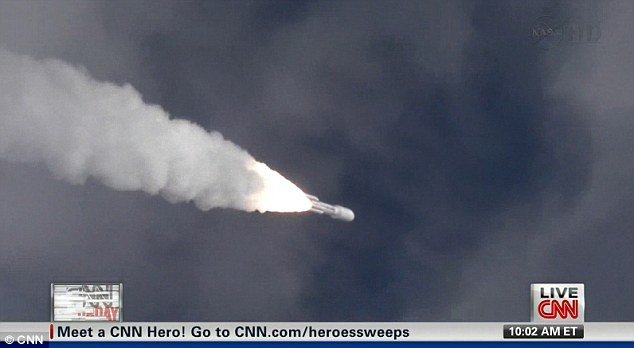
Curiosity, the world's biggest extraterrestrial explorer has been launched today on a 354 million mile journey to Mars that hopes to discover whether the desolate planet was ever capable of supporting life
Curiosity is a mobile lab, the size of a small car, which is expected to be lowered by giant jet pack on to the surface of Mars in August 2012.
Doug McCuistion, director of NASA’s Mars exploration programme said:
“It will be the largest and most complex piece of equipment ever placed on the surface of another planet.”
NASA’s earlier Viking rovers concluded 35 years ago that there was no sign of life, but scientists hope Curiosity’s more sophisticated equipment will reveal more.
It will not be able to detect living organisms in the soil, but it can look for clues by surveying the landscape with high-definition cameras on top of a 10 ft mast.
Curiosity has a laser that can break rocks as far as 23ft away to determine their chemical composition and look for traces of organic compounds.
The rover also carries an instrument that detects methane, a weather station to monitor Martian temperatures, humidity and wind, and a radiation detector that can help to determine if the planet is safe for human visitors.
One of the main tasks of Curiosity, a $2.5 billion mission, will be to discover the source of the methane gas scientists have detected in the Martian air.
Some experts believe that just as cows emit methane on Earth, so micro-organisms able to live without oxygen may be producing it on Mars.
If that is the case, say NASA scientists, then life on Earth may have originally come from the red planet – making us all, in a sense, Martians.
According to their controversial theory, Mars – a smaller planet that would have cooled quicker than Earth after the solar system’s explosive creation – would have had the conditions for life to develop long before our world.
Chunks of Martian rock containing living microbes could have been blasted into space by the impact of asteroids before landing on Earth, starting life here.
Travelling at a tenth of a mile per hour, Curiosity will take two years to complete its mission.
[youtube 7-LudR2pQyU]
[youtube _KLxmGLZQSY]
2005 YU55, an asteroid the size of an aircraft carrier whistled past Earth at a distance of 202,000 miles away, slightly nearer than the moon, on November 8.
The asteroid is the largest such object to come so close in 35 years but NASA said ther is no chance of impact with the space rock known as 2005 YU55.
NASA has been monitoring the quarter-mile-wide asteroid as it approached Earth.
The researchers will now analyze radar images to uncover further details about the rock, which was first spotted in 2005 by the University of Arizona.
YU55 asteroid’ surface is coal black and it spins slowly through space. It travels at 30,000 mph and was last this close to Earth some 200 years ago.
The last time a large cosmic interloper came that close to Earth was in 1976, and it won’t happen again until 2028.
However, it was bad news for all but the most committed of stargazers. It was not visible to the naked eye – even at its closest point to Earth it was about 100 times dimmer than humans can observe naturally.
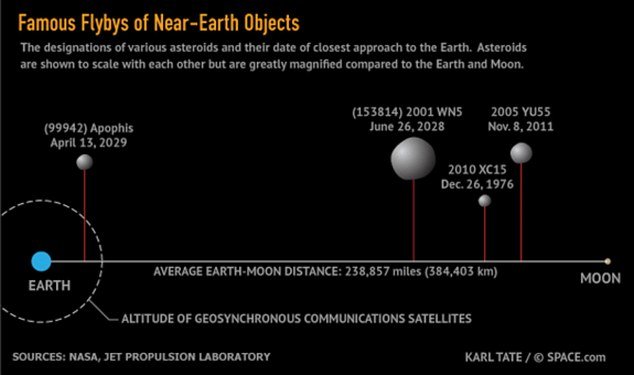
2005 YU55, an asteroid the size of an aircraft carrier whistled past Earth at a distance of 202,000 miles away, slightly nearer than the moon, on November 8
If somebody wanted to catch a glimpse of YU55 asteroid as it passed by, the person would have needed a telescope with an aperture of at least six inches and to be out of a city or away from any light pollution.
Sky & Telescope magazine published charts that show YU55’s progress through the constellations.
Scientists at NASA’s Deep Space Network in the California desert have tracked the quarter-mile-wide asteroid since last week as it approached from the direction of the sun at 29,000 mph (46,671 kph).
Yesterday, NASA offered two places to take a closer look at the action – Asteroid And Comet.
Scientists tracked YU55 with antennae of the agency’s Deep Space Network at Goldstone, California, and the Arecibo Planetary Radar Facility in Puerto Rico.
The Clay Center Observatory in Massachusetts planned an all-night viewing party so children and parents could peer through research-grade telescopes and listen to lectures.
The asteroid can’t be detected with the naked eye.
For those without a telescope, the observatory streamed video of the flyby live on Ustream, attracting several thousand viewers.
If an asteroid that size were to hit, the impact would carve a crater four miles (6.4 km) across and 1,700 feet (518 metres) deep. And if it slammed into the ocean, it would trigger 70-foot (21-metre) high tsunami waves.
The space experts recently estimated that more than 90% of the near-Earth asteroids wider than 0.6 miles have been identified, but that thousands of asteroids in YU55’s size range remain undetected.
For a lighthearted look at our close encounter, Facebook features countless event pages, and the asteroid even has its own Twitter account (@AsteroidYU55). Search for YU55 or #YU55 for a plethora of tweets.
[youtube cIwX0Qeid9o]
[youtube Z0GuRj1ve1M]
The dead satellite fell into a part of the southern Pacific Ocean about as far from large land masses as you can get, NASA officials said on Tuesday.
NASA calculations put the 6-tonne satellite‘s death plunge early Saturday thousands of miles from northwestern North America, where there were reports of sightings.
Instead, the satellite plunged into areas where remote islands dot a vast ocean.
NASA says those new calculations show the 20-year-old satellite entered Earth’s atmosphere generally above American Samoa.
But falling debris as the satellite broke apart did not start hitting the water for another 300 miles to the northeast, southwest of Christmas Island, just after midnight EDT Saturday.

The satellite fell to Earth on Saturday morning, with debris landing in remote parts of the Pacific Ocean
Experts believe about two dozen metal pieces from the bus-sized satellite fell over a 500-mile span.
“It’s a relatively uninhabited portion of the world, very remote,” NASA orbital debris scientist Mark Matney said.
“This is certainly a good spot in terms of risk.”
Scientists who track space junk couldn’t be happier with the result.
“That’s the way it should be. I think that’s perfect,” said Bill Ailor, director of the Center for Orbital and Reentry Debris Studies at the Aerospace Corp.
“It’s just as good as it gets.”
Last Saturday, scientists said it was possible some pieces could have reached northwestern Canada and claims of sightings in Canada spread on the Internet.
However, NASA said Tuesday that new calculations show the satellite landed several minutes earlier than they thought, changing the debris field to an entirely different hemisphere.
“It just shows you the difference that 10 or 15 minutes can make,” said Harvard University astrophysicist Jonathan McDowell, who tracks man-made space objects. On Saturday, he noted: “We were talking about, <<Wow, did it hit Seattle?>>”
NASA won’t say how it knows the climate research satellite came in earlier, referring questions to the U.S. Air Force space operations centre.
Air Force spokeswoman Julie Ziegenhorn said better computer model reconstruction after the satellite fell helped pinpoint where the satellite (Upper Atmosphere Research Satellite) returned to Earth.
After UARS was launched in 1991, NASA and other space agencies adopted new procedures to lessen space junk and satellites falling back to Earth. So NASA has no more satellites as large as this one that will fall back to Earth uncontrolled in the next 25 years, according to NASA orbital debris chief scientist Nicholas Johnson.
But other satellites will continue to fall. Late in October, or early in November, a German astronomy satellite is set to plunge uncontrolled back to Earth.
While slightly smaller than UARS, the German satellite is expected to have more pieces survive re-entry, said Jonathan McDowell, who worked on one of the instruments for it.
The German ROSAT satellite was launched in 1990, died in 1998 and weighs 2 ½ tons. The German space agency figures 30 pieces weighing less than 2 tons will survive re-entry. Debris may include sharp mirror shards.
The German space agency puts the odds of somebody somewhere on Earth being hurt by its satellite at 1-in-2,000 – a slightly higher level of risk than was calculated for the NASA satellite. But any one individual’s odds of being struck are 1-in-14trillion, given there are 7 billion people on the planet.
A new post on NASA’s official Twitter account said of the falling satellite: “Re-entry prediction now later than expected – tonight or late Saturday morning,” at just before noon Eastern Time.
It seemed that NASA’s earlier prediction of a landing late this afternoon was wrong. A second update from NASA said, “predicted re-entry moving later.”
Meanwhile, NASA official website reveals that the satellite‘s orientation has changed during its plunge – and that its rate of descent was “changing”, making it difficult for NASA computers to predict the time or place of landing.
“There is now a low probability debris that survives re-entry will land in the United States.”
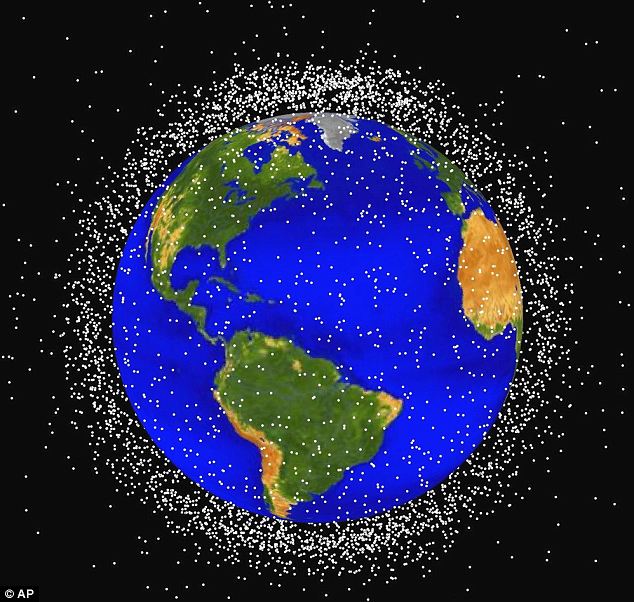
The falling satellite is one of the thousands of objects in Earth orbit being tracked by NASA
The space agency says there is a one in 3,200 chance the falling satellite will hit someone.
The satellite, which has six tons, is being tracked by all available equipment including a giant radar at RAF Fylingdales on the North York Moors on its path towards Earth.
NASA admits that it cannot predict the time or place of re-entry with any certainty – “but predictions will become more refined in the next 12 to 18 hours.”
A period of “12 to 18 hours” seems unnervingly close to when the huge Upper Atmosphere Research Satellite (UARS) will break up on entering the Earth’s atmosphere, throwing chunks of metal weighing up to 350 lb across hundreds of miles.
The space agency said it will only know 2 hours before impact where it will land and even that prediction will only be accurate to the nearest 6,000 miles.
The satellite landing could be anywhere between the 57th parallel north, which crosses Britain at around Inverness, and the 57th parallel south, which passes just below South America.
Worldwide interest in the satellite is growing: a website set up to “track” the falling satellite is constantly crashing under incredible demand, and an app for Android smartphones, Satellite AR, allows people to “see” where it is at any moment.
An amazing video captured the satellite earlier this week as NASA experts slowly narrowed down the area where it could strike.
Astrophotographer Thierry Legault’s clip, shot in northern France, shows the 20-year-old UARS satellite, appearing as a beaming mass of light as it careers to Earth.
The station at RAF Fylingdalers was originally built at the height of the Cold War to track any incoming ballistic missile attack – a role it still performs.
A RAF spokeswoman said:
“The Space Operations Room at Royal Air Force Fylingdales is manned 24 hours a day by specialist Royal Air Force and civilian personnel, and its operators will be working to track the UARS object as it returns to the atmosphere.
“The Solid State Phased Array Radar is being tasked by the United States Air Force and the Royal Air Force to concentrate its radar energy towards the object in order to track its final orbit.”
“This information will then be used by various different agencies to predict the path of re-entry into the Earth’s atmosphere.”
Initially, the satellite was expected to come crashing down through the atmosphere on Friday evening, GMT. On Thursday, the Aerospace Corporation in California predicted that re-entry will occur over the Pacific Ocean.
The satellite, which is 20-year-old, is the biggest NASA spacecraft to fall uncontrolled from the sky in 32 years.
The satellite is expected to break into more than 100 pieces as it enters the atmosphere, most of it burning up.
The heaviest metal parts are expected to reach Earth, the biggest chunk weighing about 300 lb (135 kg). The debris could be scattered over an area about 500 miles long.
[youtube TPP766kxU1U]
[youtube PPCRBzv48CY]
A satellite, weighing six tons and currently out-of-control, will strike Earth at 18,000 mph and could land almost anywhere this evening – NASA warned last night.
The satellite has the size of a bus and will break up on entering Earth’s atmosphere, flinging huge chunks of metal weighing up to 350 lb (150 kg) across hundreds of miles.
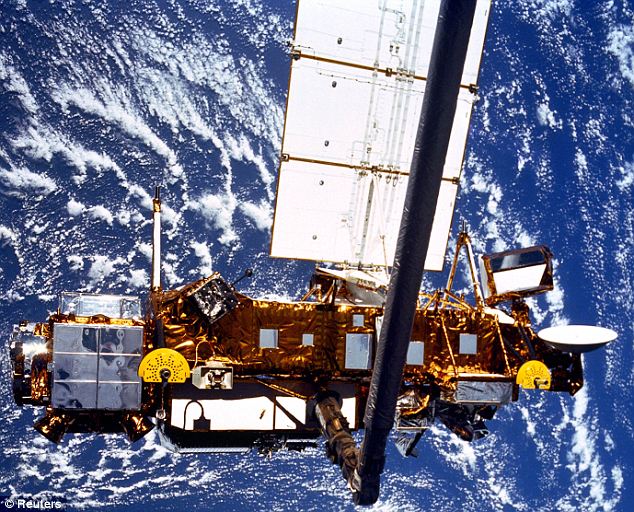
The six-ton Upper Atmosphere Research Satellite will crash to Earth this evening
NASA said its specialists will only know two hours before impact where it will land – and even that prediction will only be accurate to the nearest 6,000 miles. The satellite could land anywhere between the 57th parallel north, which crosses Britain at around Inverness, and the 57th parallel south, which passes just below South America.
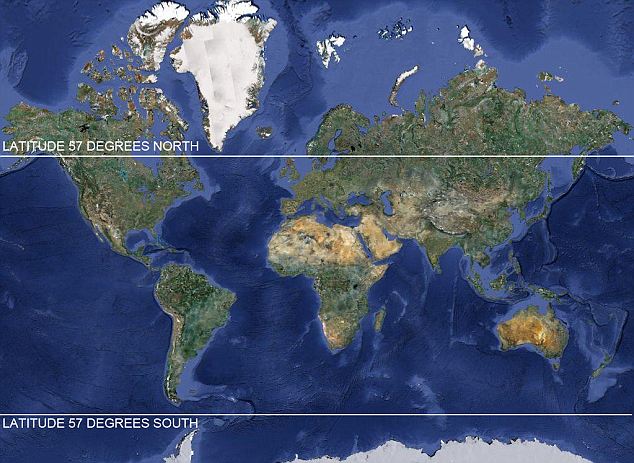
The satellite could land anywhere between the 57th parallel north, which crosses Britain at around Inverness, and the 57th parallel south, which passes just below South America
The plummeting six-ton satellite has been caught on film.
Astrophotographer Thierry Legault’s clip, shot in northern France, shows the 20-year-old Upper Atmosphere Research Satellite (UARS), appearing as a beaming mass of light as it careers to Earth.
[youtube TPP766kxU1U]
NASA orbital debris scientist Mark Matney admitted:
“We know it is going to hit somewhere between 57 north and 57 south, which covers most of the inhabited world, unfortunately.”
However, scientists have ruled out the Upper Atmosphere Research Satellite striking North America.
The satellite orbit has been altered by NASA deliberately to make it crash – but it is now coming down sooner than expected due to changed atmospheric conditions.
The satellite is falling to Earth at 5 miles per second, faster than previously thought and experts say there is a one in 3,200 chance of someone being hit by debris – more likely than getting a hole in one during a round of golf.
The NASA satellite, which measures 35ft (12 meters) and weighs 6.5tonnes, was put into space in 1991 to monitor climate change, and ceased its operations in 2005.
The falling satellite will look like a fiery meteor shower as it begins to burn up in the atmosphere.
It is expected that satellite will break into more than 100 pieces with most of it being destroyed before it hits the ground. But around 26 pieces are expected to make it through and the heaviest metal parts are expected to reach Earth, including titanium fuel tanks.
NASA spokesman Steve Cole said:
“Anybody who finds a piece of the satellite should stay away from it and call the police and let them deal with it.
“It could be very hot or it could be dangerous. It depends on what speed the debris is going, but it could go be going fast enough to go through a house.
“We will have to wait and see if the debris creates a crater. If it is spherical that is possible but if it has a less regular shape it may not be going so fast.”
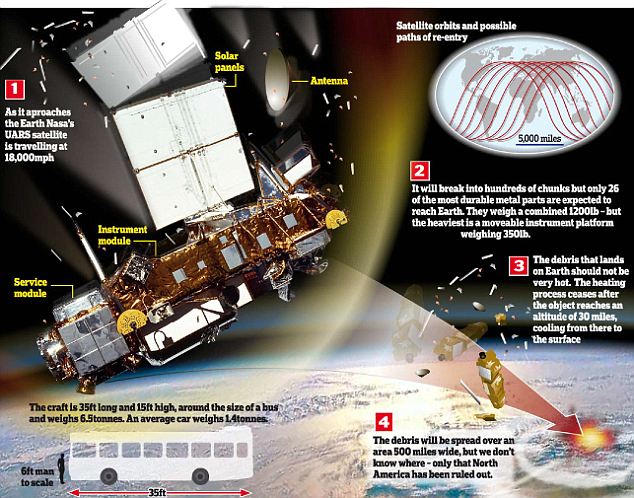
The satellite has the size of a bus and will break up on entering Earth’s atmosphere, flinging huge chunks of metal weighing up to 350 lb (150 kg) across hundreds of miles
Steve Cole added that more accurate predictions are expected throughout today and will be posted on NASA’s website.
Debris routinely falls to Earth from space but the Upper Atmosphere Research Satellite will be the biggest NASA craft to fall uncontrolled from space in 32 years.
In 1979, Skylab, which was 15 times bigger, rained charred chunks on the Indian Ocean and Western Australia after NASA said it would land in South Africa.
In 2003, when the space shuttle Columbia exploded upon re-entry killing its entire crew, large chunks of its shell landed across Texas.
 Prev123Page 3 of 3
Prev123Page 3 of 3
























